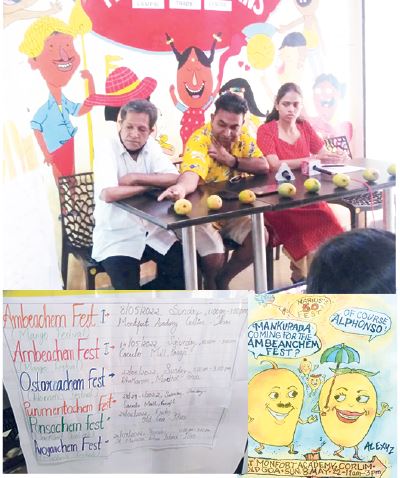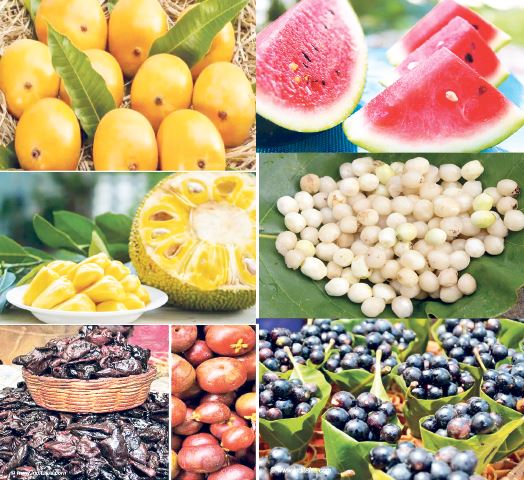Caption 1- Goa’s bounty of seasonal tropical fruit, here are some summer times favourites… mangoes, watermelons, jackfruits, kokum, karanda, chuna, etc
By Tara Narayan
IT’S the merry month of May and one of the hottest summer times I’m living through currently. Goa has never been so hot before with day time temperatures touching 40 degrees C. Capital city Panaji was an old-world town of gardens, parks and playgrounds but they’re all looking pretty scorched these days through neglect, lack of repairs and maintenance and regular watering morning and evening.
Ponjekars of all age groups should seek out a walk in the garden morning and night but they don’t, I see only the children of the poor kick a ball or idle away dreaming of ache din on the leather seat swings and tacky broken plastic merry-go-rounds and slides which are waiting for the rain to give them a good wash. I’m got my little old Caranzalen children’s and seniors park without a name where I stay in mind.
This little park is just at my doorstep and I say hello to it on my way out and in, along with these grand tamarind, mango and peepal trees.
When the heat is so searing I see a good tree and I want to go stand, sit or lie down beneath it! It’s one of my oldest timeless wishes of life! Trees of life are natural air-conditioners, coolers, oxygen providers… gifts of a benign Mother Earth (until we cross certain limits and turn her into a malignant Mother Earth, Kali Durga).
In our zest to become crorepati several times over in government and private life we think nothing of butchering entire hillsides and forests of trees—for development and progress. What kind of development and progress to turn life into a hell for the many and an artificial utopia for the few who have more than they need, more than they want and are just on a sickly rollercoaster of greed beyond imagination — they turn into our monsters of the times!(For example, Russia’s President Putin…and I can think of other monsters in the making we are familiar with in Goa and Bharatdesh).
If you’re asking me I would preach more gardens of paradise as retreats for praying, rest and recreation for men, women and children –along with the other children of Mother Earth and Father Sky. No more temples, churches or mosques! Excuse me or don’t excuse me, for me the divine is more feminine than male as in…er…maybe ardanareshwar! Gardens of paradise are our natural inspiration for prayer and gratitude.
Okay, no more of such talk! Back to summertime in Goa! After a long time I caught up with my friend festakar Marius Fernandes of Ambeachem vaddo in St Mathias Divar Island, who I remember to be the heart and soul behind several educative and entertaining fruit festivals or fests, some of them in the spacious church grounds of Goa. This summer he’s orchestrated a join collaboration Ambeachem Fest (Mango Festival) together with Prakash Kamat and some others who have come together to do an interesting – no politicians, no advertising — free for all festival of mangos. When? At Corlim this Sunday, May 8.
Here the king of fruit will get a grand presentation, on exhibit as for sale too I hope. Highlights include a grafting lesson from young agricultural teacher Pariyanka V Naik and she will also be in discussion with language instructor and TV anchor Gwen Gomes and Miguel Braganza on the future of Goan mangoes. Marius always beings a certain magical touch to al his fests and if I were you I’d be there at the Montfort Academy, Corlim (just after old Goa road going to Ponda, next to CIBA) on Sunday to have a mangolicious time!
Mangoes there are a plenty in the Panaji market these days with Goa’s mankurad selling out at Rs400 dozen (but very small fruit, I like to buy fruit which has a good aroma and hasn’t been washed clean off the natural glisten of fruit sap ooze, it must also be warm to feel. The sweetness of naturally ripened mangoes is unmistakeable. So other mango varieties to be seen are, alphonso, malgese totapuri and the little ghota mangoes , wild mangoes which go into the making of a lip-smacking Goan mango curry called sasav …these little wild mangoes can be more flavorful and mango curry goes well with rice or millet roti (discerning folk nowadays prefer to eat our wonderful variety of millets and rice nowadays in roti or pulao recipes).
I’M SUFFERING from summer time blues big time with all the power outages and irksome sweaty heat. Nothing would give me more pleasure than to run away to one of my favourite Ayurveda retreats (there are so many of them nowadays although few of them live by any Gandhian principles of being available to the common people budget-wise, sorry, there are some down south India in Kerala I think). In any case a quick reading of one of my favourite texts, namely “Dhanwantari” by Harish Johari brings me to this chapter on Home Remedies.
According to Johari, “The adoption of two simple practices will keep the human system free of all diseases: rising every day well before the sun, and confining all food intake to one meal daily.” I don’t know about that! We modern human beings whose lifestyles revolve around the cooking and eating and socializing around food — it may be difficult to restrict food intake and nowadays I don’t see folk fasting once a week or one month in a year either. Fasting is actually a natural form of detoxing. Johari’s book is one fascinating book which also offer towards the end an insight into colors and the use of gemstones, you’ll be surprised how much there is to it!
This is a super handbook for daily life if you want to get a copy for of it for yourself. Hard to put into practice in our rubbish times however!
A few tips which catch my eyes at random this time’s reading anew…
If you suffer angina pain: Mix a paste of two ripe bananas in 10 grams of honey and consume presumably.
For heart burns: Squeeze one lemon in one glass of fresh water and drink.
For long hair for ladies: Use one white radish with salt and black pepper every noon for six months regularly. It will improve the skin texture and make the hairs long.
Bad odour of mouth: Take 50 g of rose water and squeeze half a lemon in it. Rinse the mouth with this mixture. It cures wounds of the gums, strengthens the gums – and removes bad odour of the mouth.
Arthritis: Two medications have proven especially helpful for patients of arthritis. One-half medium garlic clove swallowed whole with warm water an hour before morning food provides heat and lubrication to the joints. This should be practised daily for at least 40 days. The second medication is curious but here it is: Buy pure, fresh beeswax and roll into 40 balls about the size of garbanzo beans (chickpeas). If possible, cover the balls in silver paper (an Indian medicine available from bazaar of India), using one-half sheet per ball. Take one each morning with warm milk for 40 days. (My advice, proceed with caution with this one though or take further advice!)
If you are an angry type of person stay away from hot, spicy foods and sugar and heat-producing foods. Stay with cooling foods, such as yogurt and squash…“one-third of the juice of an average coconut taken as the first beverage of the morning for 40 days will cure chronic anger.”

Oh, there is so much more amusing and raising several questions. The good vaid of Ayurveda calls lemons as “the great healer” and has lots of lemon-based medicines and then there is black pepper…“Many renunciates live on a diet consisting wholly of seven black peppercorns a day, washed down with a glass of lukewarm water. How is this possible? Black pepper contains all the five elements in equal measure in a form which excites the body to recycle chemicals already present in the system so that no new foods are needed. For this reason yogis have long considered the lowly pepper one of nature’s most perfect foods. To prevent all diseases black peppers should be taken first thing after morning centring activities. They may be swallowed whole or ground and taken as a tonic mixed with honey…”
Hey, some of it may sound bizarre to us modern humans but let me tell you Harish Johari is a poet, artist, musician, teacher, farmer, philosopher, scholar and translator…also physiologist, historian and expert cinematographer. He was born in 1934 in Bareilly, Uttar Pradesh and his father, a yogi and magistrate, taught the development of the body and consciousness…Johari’s extraordinary childhood has made him one of Urdu literature’s most memorable personalities and yes, his books have been published in English, Dutch, German and Spanish. He is widely travelled and is he still alive with his family in Princeton, NJ and Berkeley, California? I must find out!
If you are interested in Harish Johari, look him up begin by reading his “Dhanwantari” (How India’s ancient art of living and healing can give you a healthier, happier , more joyous life?)
That’s all for now. Enjoy the rest of this May’s summertime gifts!
